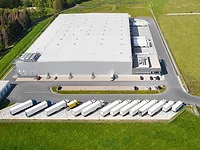Improved Dirt Pickup Resistance Critical to Future Coating Innovation
In the past few years, researchers and market managers at Dow UCAR Emulsion Systems have come to a realization based on ongoing discussions with customers. To properly enable formulators in developing new technologies for applications such as low-VOC paints, elastomeric coatings and others, the industry first needs new solutions to the age-old problem of dirt pickup.
This is the first in a series of three articles about dirt pickup resistance. Article 1 defines relevant issues and trends driving the need to conduct more research and product development for improved dirt pickup resistance. Articles 2 and 3 will outline how the industry is addressing the issue through new technologies, products and application-specific initiatives.
Dow UCAR Emulsion Systems is addressing the issue of dirt pickup resistance head on with a focused R&D platform. This is in direct response to formulator requests and clear growth in specific high-value opportunities in the industry, specifically low-VOC formulations, elastomerics and new building construction worldwide.
Low-VOC Architectural Coatings
In order to comply with Rule 1113, published by the South Coast Air Quality Management District (SCAQMD), most national architectural coatings companies are formulating paints that contain less than 50 g/L VOC, down from 150 g/L in most other regions. To meet these standards, latex manufacturers have to decrease the glass transition temperature (Tg), or the point at which the material changes from a rubbery to a stiff (glass-like) state.
In traditional latexes for architectural coatings, the glass transition temperature averages between 20 and 40 oC. In low-VOC formulations, the average Tg is closer to 0 oC. As a result, the coatings are softer and tackier, even when fully dried, than traditional coatings, causing them to capture dirt and dust easier, especially in warmer, more humid climates.
While dirt pickup resistance is only one trade off in low-VOC formulations, it is the most noticeable change, especially in traditional exterior house paints and elastomeric coatings. Before the average consumer will accept wide-scale use of low-VOC paints, the industry will need to address the issue of dirt pickup.
Elastomeric Coatings
Because of softer formulations, developers of acrylic-based elastomeric coatings have always struggled with dirt pickup. In response, they often resorted to more costly raw material blends or limited the use of elastomerics to areas where dirt pickup was less of a concern, such as interior applications.
Sector growth, driven by new applications, is changing that trend. Once considered specialty coatings, elastomerics are now one of the fastest growing segments in the industry. According to information published by analyst firm Frost & Sullivan, the North American elastomerics market is expected to grow from $620 million in annual revenue in 2004 to more than $1.2 billion by 2011.
One of the strongest growth areas for acrylic-based elastomerics is in white roof coatings, primarily in the Southwestern United States. According to a report published by The Roof Coatings Manufacturers’ Association, “The two main purposes of white coatings are 1) to protect roof membranes, resulting in longer roof life cycles; and 2) to reflect solar radiation, resulting in lower energy costs.” The report claims these coatings reduce energy costs in a single-family home by as much as 25 percent.
Wind-blown dust and dirt decrease the reflectivity of the coatings and require re-covering the roof every three to seven years. Improved dirt pickup resistance will result in longer product life cycles and better functionality in these applications.
New Construction and Maintenance Worldwide
According to a report by CNN in December 2006, more than 425 new skyscrapers are expected to be built in Asia and the Middle East in the next 10 years – and they are being built higher than ever before. In South Korea, there are plans for at least three buildings taller than 1,700 feet – which would make them the three tallest buildings in the world.
In existing skyscrapers, façade maintenance and cleaning rank among the highest ongoing costs, especially in emerging urban or industrial areas where airborne dust is more of a problem. In these applications, improved dirt pickup resistance will extend the life of the paint and significantly reduce building maintenance costs.
Summary
Developing better dirt pickup resistance is among the most important issues in the coatings industry today, and presents tremendous opportunities for progressive raw material manufacturers and formulators. Kline and Company, a leading raw materials analyst firm, called dirt resistance paints a “major growth area” in the chemicals market, specifically in growing economies such as India.
Understanding the issues related to dirt pickup resistance will help industry leaders develop the new technologies needed for the next generation of coatings products, including more functional low-VOC formulations, better elastomerics and products suited for the impending boom in new building construction worldwide.
For more information about dirt pickup resistance or Dow UCAR Emulsion Systems, visit www.ucarlatex.com.
Sidebar:
Dirt Pickup Resistance Research at Dow UCAR Emulsion
Systems
During the first stages of the current dirt pickup resistance initiative, the R&D team is focusing on several areas to obtain the data necessary for product development. They are described as follows.
Defining surface characteristics associated with dirt pickup. Researchers are looking closely at the factors, including low Tg, that result in accumulation of dust and dirt. Gaining a better understanding of these characteristics will help design new products and technologies to address the issue.
Surface degradation modeling. In addition, researchers will look at how those surface characteristics change throughout the life of the coating – using more than 30 years of historic data obtained through the company’s long history and test fence programs.
Real-time testing protocols in all major geographies. Currently there are no established testing protocols for measuring dirt pickup resistance in paints and coatings. Dow UCAR Emulsion Systems is working with select customers and organizations in each of the major geographies to establish repeatable methods for testing dirt pickup resistance.
Looking for a reprint of this article?
From high-res PDFs to custom plaques, order your copy today!




